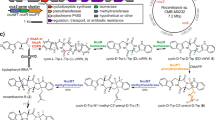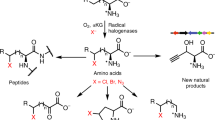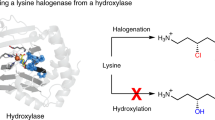Abstract
Halogen atom incorporation into a scaffold of bioactive compounds often amplifies biological activity, as is the case for the anticancer agent salinosporamide A (1), a chlorinated natural product from the marine bacterium Salinispora tropica. Significant effort in understanding enzymatic chlorination shows that oxidative routes predominate to form reactive electrophilic or radical chlorine species. Here we report the genetic, biochemical and structural characterization of the chlorinase SalL, which halogenates S-adenosyl-L-methionine (2) with chloride to generate 5′-chloro-5′-deoxyadenosine (3) and L-methionine (4) in a rarely observed nucleophilic substitution strategy analogous to that of Streptomyces cattleya fluorinase. Further metabolic tailoring produces a halogenated polyketide synthase substrate specific for salinosporamide A biosynthesis. SalL also accepts bromide and iodide as substrates, but not fluoride. High-resolution crystal structures of SalL and active site mutants complexed with substrates and products support the SN2 nucleophilic substitution mechanism and further illuminate halide specificity in this newly discovered halogenase family.
This is a preview of subscription content, access via your institution
Access options
Subscribe to this journal
Receive 12 print issues and online access
$259.00 per year
only $21.58 per issue
Buy this article
- Purchase on Springer Link
- Instant access to full article PDF
Prices may be subject to local taxes which are calculated during checkout



Similar content being viewed by others
References
Feling, R.H. et al. Salinosporamide A: a highly cytotoxic proteasome inhibitor from a novel microbial source, a marine bacterium of the new genus Salinospora. Angew. Chem. Int. Edn. Engl. 42, 355–357 (2003).
Maldonado, L.A. et al. Salinispora arenicola gen. nov., sp. nov. and Salinispora tropica sp. nov., obligate marine actinomycetes belonging to the family Micromonosporaceae. Int. J. Syst. Evol. Microbiol. 55, 1759–1766 (2005).
Williams, P.G. et al. New cytotoxic salinosporamides from the marine actinomycete Salinispora tropica. J. Org. Chem. 70, 6196–6203 (2005).
Voorhees, P.M., Dees, E.C., O'Neil, B. & Orlowski, R.Z. The proteasome as a target for cancer therapy. Clin. Cancer Res. 9, 6316–6325 (2003).
Chauhan, D. et al. A novel orally active proteasome inhibitor induces apoptosis in multiple myeloma cells with mechanisms distinct from Bortezomib. Cancer Cell 8, 407–419 (2005).
Beer, L.L. & Moore, B.S. Biosynthetic convergence of salinosporamides A and B in the marine actinomycete Salinispora tropica. Org. Lett. 9, 845–848 (2007).
Udwary, D.W. et al. Genome sequencing reveals complex secondary metabolome in the marine actinomycete Salinispora tropica. Proc. Natl. Acad. Sci. USA 104, 10376–10381 (2007).
Vaillancourt, F.H., Yeh, E., Vosburg, D.A., Garneau-Tsodikova, S. & Walsh, C.T. Nature's inventory of halogenation catalysts: oxidative strategies predominate. Chem. Rev. 106, 3364–3378 (2006).
Dong, C. et al. Crystal structure and mechanism of a bacterial fluorinating enzyme. Nature 427, 561–565 (2004).
Huang, F. et al. The gene cluster for fluorometabolite biosynthesis in Streptomyces cattleya: a thioesterase confers resistance to fluoroacetyl-coenzyme A. Chem. Biol. 13, 475–484 (2006).
Deng, H. et al. The fluorinase from Streptomyces cattleya is also a chlorinase. Angew. Chem. Int. Edn. Engl. 45, 759–762 (2006).
Lam, K.S. et al. Effects of halogens on the production of salinosporamides by the obligate marine actinomycete Salinispora tropica. J. Antibiot. (Tokyo) 60, 13–19 (2007).
Harper, D.B. & O'Hagan, D. The fluorinated natural products. Nat. Prod. Rep. 11, 123–133 (1994).
Cadicamo, C.D., Courtieu, J., Deng, H., Meddour, A. & O'Hagan, D. Enzymatic fluorination in Streptomyces cattleya takes place with an inversion of configuration consistent with an SN2 reaction mechanism. ChemBioChem 5, 685–690 (2004).
Wuosmaa, A.M. & Hager, L.P. Methyl chloride transferase: a carbocation route for biosynthesis of halometabolites. Science 249, 160–162 (1990).
Ni, X. & Hager, L.P. cDNA cloning of Batis maritima methyl chloride transferase and purification of the enzyme. Proc. Natl. Acad. Sci. USA 95, 12866–12871 (1998).
Ni, X. & Hager, L.P. Expression of Batis maritima methyl chloride transferase in Escherichia coli. Proc. Natl. Acad. Sci. USA 96, 3611–3615 (1999).
Gust, B., Challis, G.L., Fowler, K., Kieser, T. & Chater, K.F. PCR-targeted Streptomyces gene replacement identifies a protein domain needed for biosynthesis of the sesquiterpene soil odor geosmin. Proc. Natl. Acad. Sci. USA 100, 1541–1546 (2003).
Datsenko, K.A. & Wanner, B.L. One-step inactivation of chromosomal genes in Escherichia coli K-12 using PCR products. Proc. Natl. Acad. Sci. USA 97, 6640–6645 (2000).
Jez, J.M., Ferrer, J.L., Bowman, M.E., Dixon, R.A. & Noel, J.P. Dissection of malonyl-coenzyme A decarboxylation from polyketide formation in the reaction mechanism of a plant polyketide synthase. Biochemistry 39, 890–902 (2000).
Dam, J. & Schuck, P. Calculating sedimentation coefficient distributions by direct modeling of sedimentation velocity concentration profiles. Methods Enzymol. 384, 185–212 (2004).
Schaffrath, C., Deng, H. & O'Hagan, D. Isolation and characterisation of 5′-fluorodeoxyadenosine synthase, a fluorination enzyme from Streptomyces cattleya. FEBS Lett. 547, 111–114 (2003).
Kabsch, W. in International Tables for Crystallography (eds. Rossman, M.G. & Arnold, E.) Ch. 11.3 (Kluwer Academic Publisher, Dordrecht, Netherlands, 2001).
Vagin, A.A. & Isupov, M.N. Spherically averaged phased translation function and its application to the search for molecules and fragments in electron-density maps. Acta Crystallogr. D Biol. Crystallogr. 57, 1451–1456 (2001).
Collaborative Computational Project, Number 4. The CCP4 suite: programs for protein crystallography. Acta Crystallogr. D Biol. Crystallogr. 50, 760–763 (1994).
Vagin, A.A. et al. REFMAC5 dictionary: organization of prior chemical knowledge and guidelines for its use. Acta Crystallogr. D Biol. Crystallogr. 60, 2184–2195 (2004).
Laskowski, R.A. Structural quality assurance. Methods Biochem. Anal. 44, 273–303 (2003).
DeLano, W.L. The PyMOL Molecular Graphics System (DeLano Scientific, San Carlos, California, USA, 2002).
Akopiants, K., Florova, G., Li, C. & Reynolds, K.A. Multiple pathways for acetate assimilation in Streptomyces cinnamonensis. J. Ind. Microbiol. Biotechnol. 33, 141–150 (2006).
Acknowledgements
We kindly thank D. O'Hagan (University of St. Andrews) for providing 5′-FDA and 5′-BrDA standards, B. Gust and Plant Bioscience Limited for the REDIRECT technology kit for PCR targeting, A. Lapidus (Joint Genome Institute) for fosmid BHXS3930 and R. McGlinchey for valuable discussions. A.S.E. is a Tularik postdoctoral fellow of the Life Sciences Research Foundation, and F.P. is a Deutsche Forschungsgemeinschaft postdoctoral fellow. This work was supported by grants from the US National Oceanic and Atmospheric Administration (NA05NOS4781249 to B.S.M.), the US National Institutes of Health (CA127622 to B.S.M.) and the US National Science Foundation (MCB-023602 to J.P.N.). J.P.N. is an investigator of the Howard Hughes Medical Institute.
Author information
Authors and Affiliations
Contributions
A.S.E. and F.P. contributed equally to this paper. A.S.E. performed the genetic and biochemical experiments, F.P. and A.S.E. crystallized SalL, F.P. determined the structure and performed the sedimentation velocity studies. All authors discussed the results and wrote and commented on the manuscript.
Corresponding author
Supplementary information
Supplementary Text and Figures
Supplementary Figure 1 and Supplementary Table 1 (PDF 95 kb)
Rights and permissions
About this article
Cite this article
Eustáquio, A., Pojer, F., Noel, J. et al. Discovery and characterization of a marine bacterial SAM-dependent chlorinase. Nat Chem Biol 4, 69–74 (2008). https://doi.org/10.1038/nchembio.2007.56
Received:
Accepted:
Published:
Issue Date:
DOI: https://doi.org/10.1038/nchembio.2007.56
This article is cited by
-
Fragmentation and [4 + 3] cycloaddition in sodorifen biosynthesis
Nature Chemistry (2023)
-
Aryl C-H iodination: are there actual flavin-dependent iodinases in nature?
Science China Chemistry (2021)
-
Multienzymatic synthesis of nucleic acid derivatives: a general perspective
Applied Microbiology and Biotechnology (2015)
-
Challenges and triumphs to genomics-based natural product discovery
Journal of Industrial Microbiology and Biotechnology (2014)



